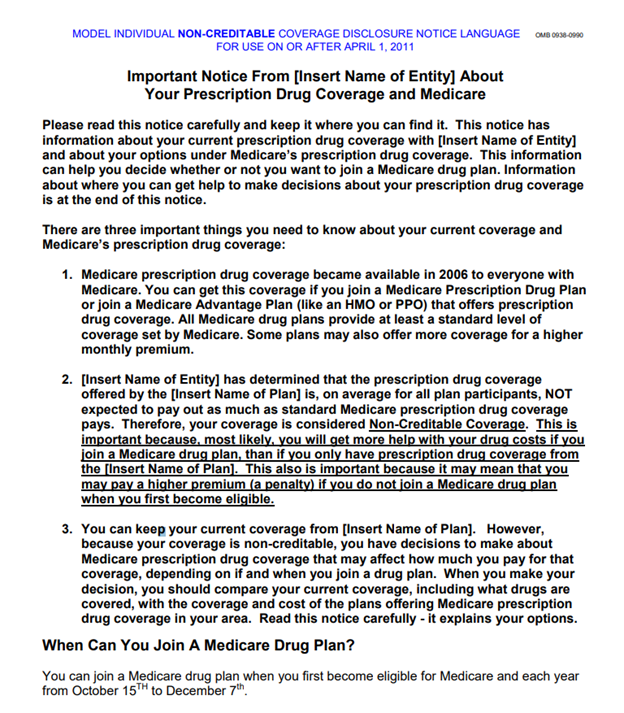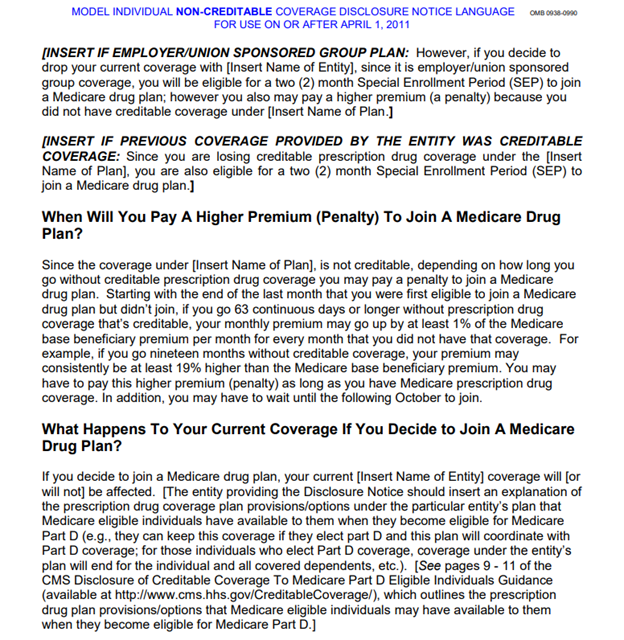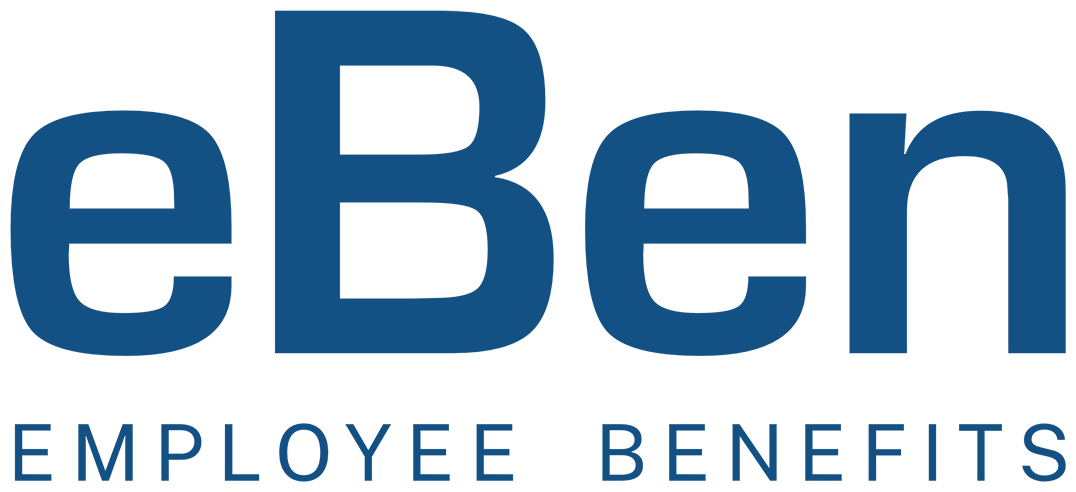This article will cover:
- Creditable coverage basics, including how to determine whether coverage is creditable
- The IRA changes impacting prescription drug coverage under employer-sponsored group health plans
- Next steps for employers
Read on for more information.
Medicare Part D
Creditable Coverage
Employers who offer prescription drug coverage must distribute a notice of “creditable” or “non-creditable” coverage to Medicare-eligible individuals before October 15, which coincides with the Medicare Part D open enrollment period (generally running from October 15 until December 7 each year). Medicare-eligible individuals who delay enrollment in Medicare Part D can incur late enrollment penalties unless they have enrolled in other creditable coverage, so the employer notice is intended to inform employees of this risk.
Prescription drug coverage is considered “creditable” when its actuarial value equals or exceeds the actuarial value of standard Medicare Part D prescription drug coverage. It is considered “non-creditable” when it does not provide, on average, as much coverage as Medicare’s standard Part D plan.
As a reminder, employers are not required to offer prescription drug plan creditable coverage to their employees. But they are required to notify Medicare Part D-eligible plan participants of their prescription drug plans’ creditable coverage status. If a plan’s status changes from creditable to non-creditable (or vice versa), employers are required to notify their Medicare Part D-eligible plan participants within 30 days of the change.
Determination of Creditable Coverage
There are two sanctioned methods to determine whether coverage is creditable for purposes of Medicare Part D — a simplified determination method and an actuarial determination method. Most employer plan sponsors can use the simplified determination method. Details from the Centers for Medicare and Medicaid Services (CMS), the federal agency governing Medicare, on the simplified determination method can be found on the CMS website by clicking here.
Below is a concise summary of the simplified determination method to deem a prescription drug coverage benefit creditable:
- The plan provides coverage for brand and generic prescriptions;
- The plan provides reasonable access to retail providers;
- The plan is designed to pay on average at least 60% of participants’ prescription drug expenses; and
- The plan satisfies at least one of the following[1]:
- The coverage has no annual benefit maximum or maximum annual benefit payable by the plan of at least $25,000;
- The coverage has an actuarial expectation that the amount payable by the plan will be at least $2,000 annually per Medicare-eligible individual; or
- For employers that have integrated prescription drug and health coverage, the integrated plan has no more than a $250 deductible per year, has no annual benefit maximum or a maximum annual benefit of at least $25,000, and has no less than a $1,000,000 lifetime combined benefit maximum.
- A combined plan year deductible for all benefits under the plan;
- A combined annual benefit maximum for all benefits under the plan; and
- A combined lifetime benefit maximum for all benefits under the plan.
Employers participating in the Retiree Drug Subsidy (RDS) program cannot use the simplified determination method and must use the actuarial determination method. This requires an attestation by a qualified actuary, using generally accepted actuarial principles in accordance with CMS actuarial guidelines. eBen|Risk Strategies has a team of qualified actuaries who can assist with this method.
For employers offering multiple plan options (for example: a PPO, an HDHP, and/or an HMO), the creditable coverage status must be determined separately for each plan option.
Purpose of the Medicare Part D Notice
There are no specific penalties for an employer who fails to provide the Medicare Part D Notice of Creditable Coverage to employees. However, Medicare Part D-eligible individuals who fail to maintain creditable coverage for a period of 63 continuous days or more will face a late enrollment penalty when they eventually enroll in Part D. As a result, this notice serves an important purpose for these individuals to prove they maintained creditable coverage and avoid late enrollment penalties when they ultimately enroll in Part D.
Notice of Creditable
Coverage Distribution
The notice of creditable (or non-creditable) coverage must be distributed to all Medicare-eligible individuals who are covered under an employer’s prescription drug coverage plan. This may include not only active employees and their covered dependents, but also disabled employees, retirees, COBRA participants, and their covered spouses and dependents in each instance. Since most employers will not generally know whether a covered spouse or dependent is Medicare-eligible, it is common practice to send the notice to all active and disabled employees, retirees, and COBRA individuals and include clear language directing the recipient to provide the notice to any Medicare-eligible spouses and dependents covered under the plan.
The notice may be mailed out as a separate, stand-alone document or included as part of open enrollment or other benefit-related materials as long as it is prominent and conspicuous within the other materials. The notices can also be sent electronically as long as plan participants have regular work-related computer access in accordance with the Department of Labor rules regarding electronic delivery methods.
What’s New for 2025
Benefit Plan Design Changes
The IRA significantly changed the Medicare Part D OOP annual costs cap from $8,000 in 2024 to $2,000 in 2025. As a result, many more employer-sponsored prescription drug plans will likely find it challenging to meet creditable coverage requirements and will be deemed non-creditable, especially Heath Savings Account (HSA) qualifying High-Deductible Health Plans (HDHPs).
If a Medicare Part D-eligible plan participant enrolls in non-creditable prescription drug coverage for 2025, they may face penalties for late enrollment in Medicare Part D.
Creditable Coverage Determination Method
Another important item to be aware of for 2025 is that employer group health plan sponsors, who historically have relied on the simplified determination method to determine their plan’s creditable coverage status, may continue to use this method for 2025.
While initially proposing to eliminate the use of the simplified determination method, CMS confirmed in its Final Part D Redesign Program Instructions that it will continue to permit the use of the simplified determination methodology, without modification, for calendar year 2025 for group health plan sponsors who are not applying for the retiree drug subsidy. CMS will reassess the continued use of the existing simplified determination methodology in future guidance, or establish a revised one for calendar year 2026.
Employer Next Steps
1. Determine Creditable Coverage Status
As a result of the changes under the IRA, employers must first determine whether their prescription drug coverage is creditable or non-creditable in preparation of distributing the applicable Medicare Part D disclosure notices to their plan participants.
Fully-Insured Plans: Employers who sponsor fully-insured group health plans should rely on their carriers to determine creditable status of their prescription drug coverage.
Self-Funded Plans: For employers with self-funded health plans (including level-funded plans), your eBen|Risk Strategies account team can assist with the creditable status determination of your prescription drug coverage if the plan’s third-party administrator or pharmacy benefit manager does not provide the determination.
2. Distribute Notices
Once the coverage’s creditable status is determined, employers are advised to prepare and distribute the notice before October 15, 2024. CMS provides model notices (accessed here), available in both English and Spanish, which employers can use to satisfy their notice distribution requirements.
3. Communicate to Impacted Plan Participants
For prescription drug plans that result in non-creditable coverage determinations (as a result of the IRA changes), communication is key to help mitigate unwelcome surprises for Medicare Part D-eligible plan participants.
As the annual Medicare Part D open enrollment season approaches (October 15 – December 7), employers are advised to communicate the potential Medicare Part D enrollment penalties that a Part D-eligible plan participant may eventually face when choosing to enroll in prescription drug coverage that is non-creditable.
Employers should be careful when communicating these changes to avoid the appearance of encouraging these plan participants to drop employer coverage and enroll in Medicare, in violation of Medicare Secondary Payer rules.
The CMS model notice for non-creditable coverage contains useful language to consider leveraging in communication efforts to Medicare Part D-eligible plan participants, particularly the two screenshots below from pages 1 and 2, respectively:


Medicare Part D-eligible plan participants who are enrolled in non-creditable prescription coverage may need to take quick action to enroll in Part D during the Medicare Part D open enrollment period to avoid a gap in creditable coverage and resulting penalties.
4. Creditable Coverage Disclosure Reporting
Employers are also required to report the creditable coverage status of their prescription drug plans to CMS within 60 days of the beginning of their plan year, which is typically March 1 for calendar year plans. For 2025 calendar year plans, this disclosure reporting deadline will be March 2, 2025. Click here for an article with more details.
5. Monitor For Future Guidance
Be on the lookout for future CMS guidance in connection with using the simplified determination method for calendar year 2026.
eBen|Risk Strategies is here to help. Contact us directly here.
Medicare Note: eBen|Risk Strategies Company and our affiliates (collectively, “eBen|Risk Strategies”) do not offer every plan available in every geographic location. Any information eBen|Risk Strategies provides is limited to those plans offered by eBen|Risk Strategies. eBen|Risk Strategies is not connected nor endorsed by the United States or any state government or Medicare program. Please contact Medicare.gov or 1-800-Medicare to get information on all your options.
[1] The Affordable Care Act prohibits health plans from imposing lifetime and annual limits on the dollar value of essential health benefits.
The contents of this article are for general informational purposes only and eBen|Risk Strategies Company makes no representation or warranty of any kind, express or implied, regarding the accuracy or completeness of any information contained herein. Any recommendations contained herein are intended to provide insight based on currently available information for consideration and should be vetted against applicable legal and business needs before application to a specific client.


